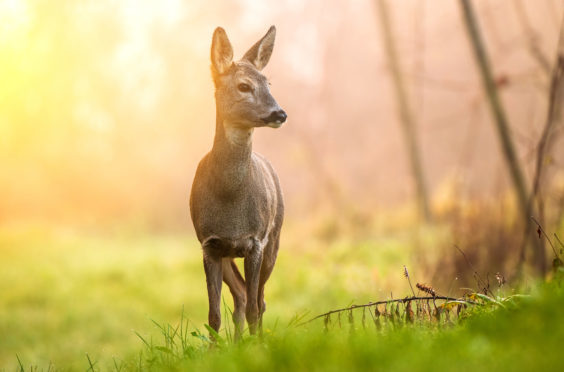It was the white that caught my eye; a flash of undulating paleness as the small group of roe deer bounded up the slope and into the thick cover of the young conifer plantation.
There was a gap in this stand of small spruces and I quickly brought my binoculars to bear upon it. Roes are curious animals and the chances are they would pause here to have a look at me. Sure enough, one, two and then finally three deer cautiously emerged into the clearing and stared back down the slope in my direction.
Ah, I do enjoy it when my second-guessing turns out to be correct, and their curiosity enabled me to examine these handsome animals in more detail. It was a buck and two does, one of which was possibly a youngster from the previous year.
The little velvet-covered antlers or prongs were showing well on the buck. They were shed only a few months ago but grow back remarkably quickly and will soon be fully formed. The adult doe in the group will undoubtedly be pregnant and in May or June will give birth to her two fawns.
The roes looked down upon me for a short while longer, before slinking away into the trees. I often see roes in this part of the eastern Ochils near Dunning and they certainly seem commoner than ever nowadays.
Indeed, when my sensor-operated trail-camera is located by badger setts or fox dens, more times than not I will capture on film a wandering roe. It’s almost as if they are attracted to such sites, although I suspect they use the same paths as badgers and foxes, which is why my camera snaps them so frequently.
Roes are so common nowadays because they are not hunted as much as in the past and have few natural predators. Foxes and eagles will take fawns, but only occasionally. All of which is good news for these attractive little deer, if not for foresters concerned about tree damage.
Roe bucks are noisy creatures and bark like a dog. I particularly enjoy the experience recounted by the early 20th century naturalist Frances Pitt when she dozed off in a Scottish forest. “I sat down with my back to a pine stump and the forest world faded from me – or rather I was back in an earlier epoch when primitive man with a wolfish dog hunted beneath the pines,” she wrote.
“Wouf, wouf, barked the dog, and I woke to realisation of an actual sound. Was a dog barking at me? No, it was a roe buck – a picture of puzzled curiosity, staring intently at me and uttering his bark of mingled surprise and alarm”.
Pitt’s reference to times past is most appropriate, for the ‘wouf, wouf’ of our barking roes would have been as familiar a sound to our forebears as the howl of the wolf or the cry of the lynx.
Info
Between March and September buck roe deer hold small defended territories. The mating season, or rut, is from mid-July to the end of August.










